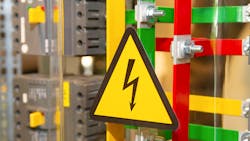Is your plant following the new NFPA 70B standard?
In January 2023, the National Fire Protection Association (NFPA) adopted the Standard for Electrical Equipment Maintenance, NFPA 70B, which had long been developed as recommended practices. The 70B standard follows other NFPA standards that address safe electrical design and installation and worker safety. Maintenance was the last aspect of electrical safety that needed to be addressed by the code.
The code does need to be adopted state-by-state, and local authorities having jurisdiction (AHJs) will oversee any enforcement, including local inspectors or the Occupational Safety and Health Administration (OSHA). It's important to understand the guidelines now and start the planning process. Many already have electrical maintenance programs and an electrical maintenance plan (EMP). If you don’t, now is the time to start.
Driving safety beyond NFPA 70E
“Anytime you’re installing, maintaining and repairing something, it’s not a normal condition,” says Douglas Beck, business development leader for consulting and digital services at Schneider Electric. For a long time, industry has been focused on NFPA 70E, which is a worker safety standard, and NFPA 70, the National Electrical Code (NEC), the original standard for safe electrical design and installation. As the last piece of electrical safety focused on maintenance, the NFPA 70B standard will add another layer of safety and more robust planning, Beck says.
“I think safety and outage caused by electrical fires are two things driven by maintenance,” he adds. “The new standard calls for a culture of preventive maintenance, but also includes a culture of safety around that.”
Many safety-centric industries already have robust EMPs, while other heavy industrial process industries may lag behind. Where manufacturing facilities operate on planned maintenance schedules or reactionary maintenance, meaning fix it when it breaks, the change in maintenance practices could be significant in the long term. Beck believes the new standard will push upper-tier facilities who already have safety and maintenance programs to world-class levels. Mid-level facilities will move toward the upper tier, and lower-level reactionary maintenance facilities will move toward the middle.
“It’s going to vary by industry,” Beck says. Consumer packaged goods is one he points to as a leader in electrical maintenance practices, and heavy industrial manufacturing, such as steel mills and foundries, will probably have farther to go.
Also, the NFPA 70B standard will drive maintenance planning and practices to much higher level for industry, he added. “It’s going to improve safety. It’s going to improve downtime in our industry. I think it’s going to do a lot of fantastic things, but overall, it’s going to take a while to get there.”
The evolution of NFPA 70B
The NFPA 70B recommendations have been around in their original form since 1967, and the original Recommended Practice for Electrical Equipment Maintenance was adopted in 1975. The latest edition of the standard for adoption was originally drafted in 2021 and went through a public review process until its adoption earlier this year.
The most significant change for the new standard is the requirement of a formalized electrical maintenance plan. To develop this EMP, an understanding of equipment condition and the condition of equipment maintenance is needed. “Assessing the maintenance condition of your equipment requires to go visually inspect and look at maintenance histories,” Beck says.” Define what state you think equipment is in.” This includes defining the criticality of each device to the operation and the potential for each device to cause a personal safety issue. For large companies with multiple locations, this could be a big undertaking, and many will look to outside resources for help.
All current equipment maintenance practices at a facility should be based on original equipment manufacturer (OEM) recommendations, and for those companies with close OEM relationships, the equipment manufacturer may be the best option to do equipment assessment, Beck says.
Manufacturers with older equipment or those that don’t have OEM support can use the equipment recommendations within 70B to start formalizing a maintenance plan. However, for the most part, the standard is not intended to supersede manufacturer’s recommended maintenance practices.
“Working with manufacturers and professionals who know what good equipment standards are, what good conditions of maintenance are, and how each particular device could impact the criticality is going to be very important in order to establish clear maintenance practices. Once you determine those three conditions, that’s when you go back and you start to look at your maintenance practices and your maintenance periodicities,” Beck says.
The process also needs someone with a strong knowledge of power distribution and systems and electrical safety. “I see there developing a very strong marriage between power distribution professionals and OEM equipment owners, working collaboratively to establish these plans and put best practices in place,” Beck said.
Elements of an electrical maintenance plan
Under NFPA 70B, plant teams are responsible for ensuring that these elements and processes are part of every EMP:
- Verify that all equipment and systems comply with applicable installation codes and standards by inspection.
- Consider the current condition of maintenance of electrical equipment and systems and the potential safety and operational risks to maintenance and operational personnel.
- Define EMP principles upon which the plan is based and goals to be achieved. It should be designed to function in conjunction with the applicable electrical safety program.
- Identify personnel responsible for implementing each element of the program.
- Survey and analyze electrical equipment and systems to determine maintenance requirements and priorities.
- Document maintenance procedures for equipment, including a plan for inspections, servicing and suitable test.
- Develop a records-retention policy for maintenance, equipment and personnel documentation.
- Outline a process to prescribe, implement and document corrective measures based on collected data.
- Develop a process for incorporating design for maintainability in electrical installation.
- Determine a program review and revision process that considers failures and finding for continuous improvement.
- Identify the controls by which it is measured and monitored.
- Develop a method to use feedback reports, such as electrical safety incidents, equipment malfunctions, unintended operation or alarms, and operation of protective devices, for EMP refinement.
Other EMP requirements:
- The plan should be audited at least every five years.
- The EMP should identify an EMP coordinator.
- Personnel assigned to EMP duties should be trained in the specific maintenance tasks, test methods, test equipment, PPE usage, and hazards associated with the electrical equipment of system being services.
- All training must be documented.
“The 70B rollout provides very clear direction on safety of the worker,” Beck says. “The reliability of the system really starts with that documentation, having good process and working with manufacturers to use their recommended practices and guidelines for their equipment.”
It is also not enough to have a paper EMP tucked away in a binder somewhere. “Now more than ever, it’s not good enough to just have a plan, you also need to have that plan digitized, somewhere on a server, where people can access it,” Beck says. It should be integrated with data archiving and serve as the mother documentation for the system.
Be sure to read the full standard. You can sign up for free access through NFPA to read the standard online. A paper copy can be purchased here.
Electrical fires are concern for manufacturing
The need for the NFPA 70B standard is underscored by the number and type of electrical fires in industry. According to data from the National Fire Protection Association (NFPA), historically, the majority of industrial fires are electrical in nature. From 2011 to 2015, an estimated 37,910 fires in industrial and manufacturing properties were reported, including 7,700 structure fires. Of those structure fires, electrical distribution and lighting equipment were involved in the majority (24%), and heating equipment was involved in another 16% of structure fires.
The fires cost 16 civilian lives, 273 injuries, and $1.2 billion in direct property damage. Structure fires also accounted for 29% of civilian deaths, 80% of civilian injuries, and 67% of direct property damage. Almost two-thirds (65%) of the combined industrial and manufacturing facility structure fires occurred specifically in manufacturing properties, as opposed to utility, defense, agriculture or mining properties.
Fires at industrial and manufacturing properties have fallen substantially over the past three decades from 114,500 fires in 1980 to 39,700 in 2015. The same decrease can be said for civilian deaths and injuries over this time period. This can be attributed in large part to the work done to standardize, but it should be noted that electrical fires are still a concern for manufacturing facilities.
NFPA 70, NEC and NFPA 70E
NFPA 70, NEC is the standard for safe electrical design, installation and inspection. The first version of NFPA 70, NEC was first introduced in 1897 by 1,200 individuals in the United States and Europe and was unanimously approved by the National Board of Fire Underwriters. Today, the code sets the foundation for electrical safety in residential, commercial, and industrial properties. The latest edition was released in 2023.
NFPA 70E is the Standard for Electrical Safety in the Workplace, covering safe work practices to protect personnel by reducing exposure to major electrical hazards. The first edition of the standard (Standard for Electrical Safety Requirements for Employee Workplaces) was published in 1979 and revised frequently throughout the years. NFPA recently released the 2024 edition with minor style changes. It was issued by the standards council on April 23, 2023, and approved as an American National Standard on May 13, 2023.
About the Author

Anna Townshend
managing editor
Anna Townshend has been a journalist and editor for almost 20 years. She joined Control Design and Plant Services as managing editor in June 2020. Previously, for more than 10 years, she was the editor of Marina Dock Age and International Dredging Review. In addition to writing and editing thousands of articles in her career, she has been an active speaker on industry panels and presentations, as well as host for the Tool Belt and Control Intelligence podcasts. Email her at [email protected].
